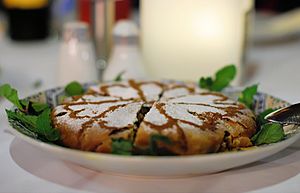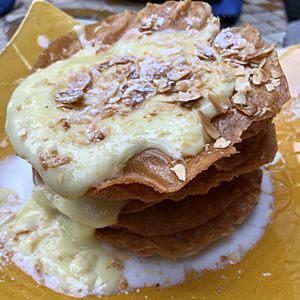Pastilla facts for kids
 |
|
| Alternative names | Bastilla, Basṭīla, R’zeema, Tajik |
|---|---|
| Type | Meat pie |
| Region or state | Maghreb |
| Associated national cuisine | |
| Main ingredients | Warka dough, broth, spices; squab, chicken, fish or offal |
Pastilla (Arabic: بسطيلة, romanized: basṭīla) is a tasty North African meat or seafood pie. It is also called the North African pie. It is made with a special dough called warqa (ورقة), which is a lot like filo dough. Pastilla is a very popular dish in Morocco and Algeria. People who moved from these countries have also brought this delicious pie to places like France, Israel, and North America.
Contents
History of Pastilla
The name of this pie, pastilla, comes from a Spanish word. In modern Spanish, pastilla can mean "pill" or "small pastry." The "p" sound in Spanish changed to a "b" sound in Arabic, which is why it's also called bastila.
Some historians think recipes similar to pastilla fillings existed way back in the 1200s. For example, old cookbooks from a place called Al-Andalus (which was in Spain) describe cooking pigeon with spices like cinnamon, saffron, and onions. The cooking method was similar to how pastilla is made today. The ingredients were cooked in a pot first, then baked in an oven.
Other historians believe the dish, or at least the werqa dough, became popular in Morocco after people moved there from Algeria in the 1830s. However, many agree that the basic idea of pastilla likely came to Morocco from Moorish Muslims who left Spain in the 1500s. There was a lot of travel between Morocco and Spain for a long time.
Jewish food historians also suggest that Pastilla started in Morocco. They say that when a type of dough called "warqa" (similar to phyllo) arrived in North Africa, cooks started using it instead of Spanish pastry. Jewish people kept saying the name with a "p" sound, while Arabic speakers changed it to a "b" sound.
In Morocco, pastilla is often served as a first course at special meals. It usually comes in two main types: one with poultry (like chicken or pigeon) and one with seafood. In Algeria, pastilla is usually made with chicken or pigeon.
Poultry Pastilla
Poultry pastilla was traditionally made with squab (young pigeons). But today, people often use shredded chicken instead. This type of pastilla has a mix of sweet and salty tastes.
It has crispy layers of werqa dough. Inside, there's savory meat that has been cooked slowly with broth and spices, then shredded. There's also a crunchy layer of toasted and ground almonds, mixed with cinnamon and sugar.
To make the filling, the poultry is browned in butter. Then, chopped onions, water, parsley, and spices like saffron are added. The meat simmers until it's very tender. Once it cools, the meat is taken off the bones and shredded. The cooking liquid is then thickened with eggs to make a creamy sauce. The meat and sauce are often prepared a day before.
Blanched almonds are fried, then crushed and mixed with powdered sugar and cinnamon. To assemble the pie, thin werqa dough sheets are layered in a round baking pan. Each sheet is brushed with melted butter. The egg mixture goes on first, then another dough sheet. Next, the shredded meat is added, covered with another dough sheet. Finally, the almond mixture is put on top. The dough sheets that hang over the edge are folded over the filling. More buttered dough sheets are added to seal the pie. The pie is baked until it's hot and the dough layers are golden brown. Before serving, powdered sugar and cinnamon are sprinkled on top. It's best served hot!
Seafood Pastilla
Seafood pastilla (Moroccan Arabic: بسطيلة الحوت, romanized: basṭīlat el-ḥūt) is made with fish and other seafood. It also often includes vermicelli noodles. Unlike poultry pastilla, the seafood version is not sweet. Instead, it is usually spicy.
While poultry pastilla is dusted with sugar and cinnamon, seafood pastilla is often topped with a light sprinkle of shredded cheese and a few slices of lemon. This type of pastilla is a popular dish served at Moroccan weddings.
Pastilla with Milk
In the traditional cooking of Fes, pastilla can also be a dessert! When it's a dessert, it's called Jowhara (جوهرة), which means "jewel," or "Pastilla with milk." This sweet pastilla is also made with warka dough. It has a milky cream placed between the dough sheets. The Jowhara is flavored with orange flower water and decorated with cinnamon and sugar.
Sephardic Jewish Version
Among Moroccan Jews, pastilla is made a little differently. They use olive oil or margarine instead of butter. This is because of kosher rules, which say you shouldn't eat dairy products and meat at the same time.
Sometimes, instead of making one big pie, people make smaller, individual pastilla pastries. These are becoming more and more popular.
See also
 In Spanish: Pastela para niños
In Spanish: Pastela para niños




